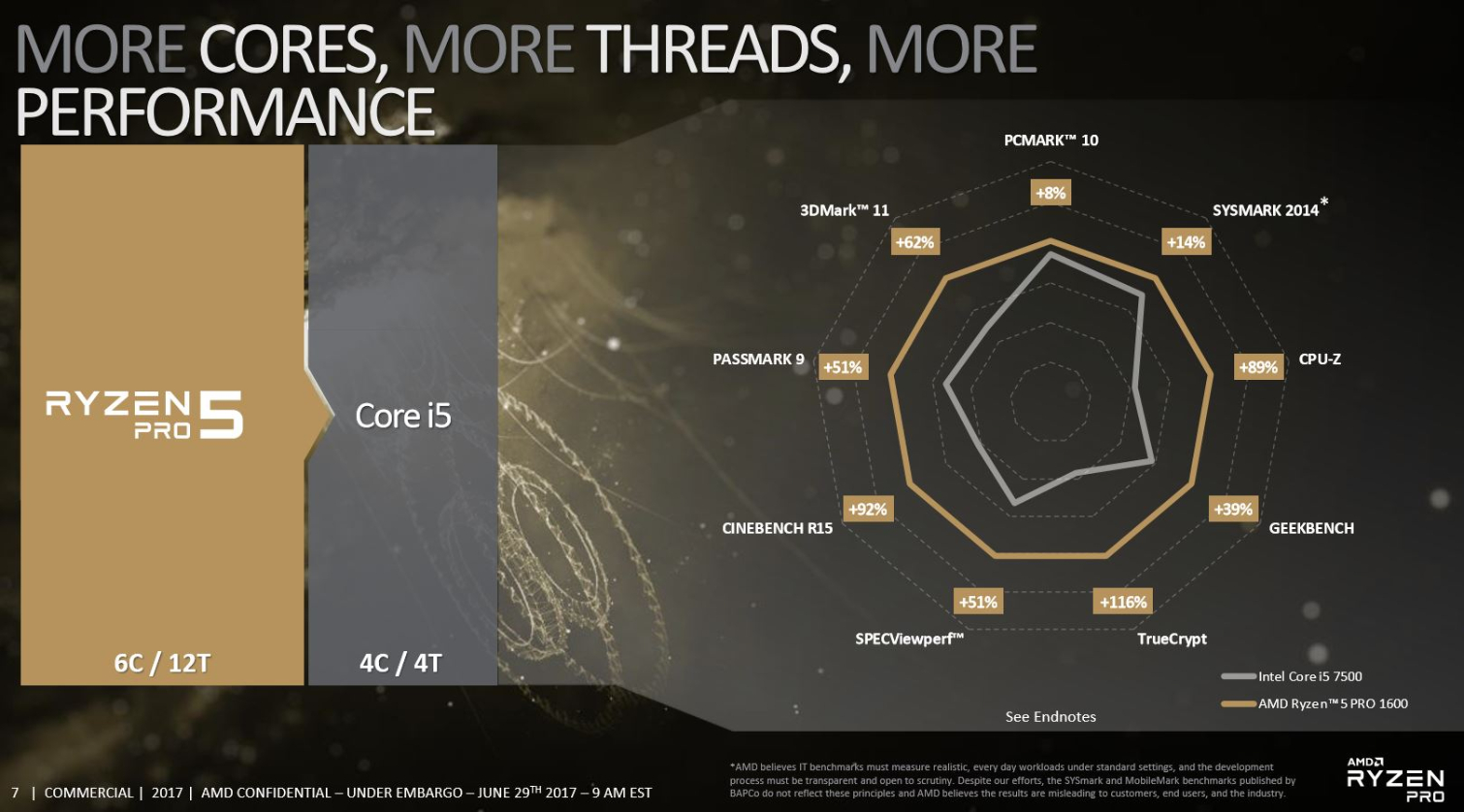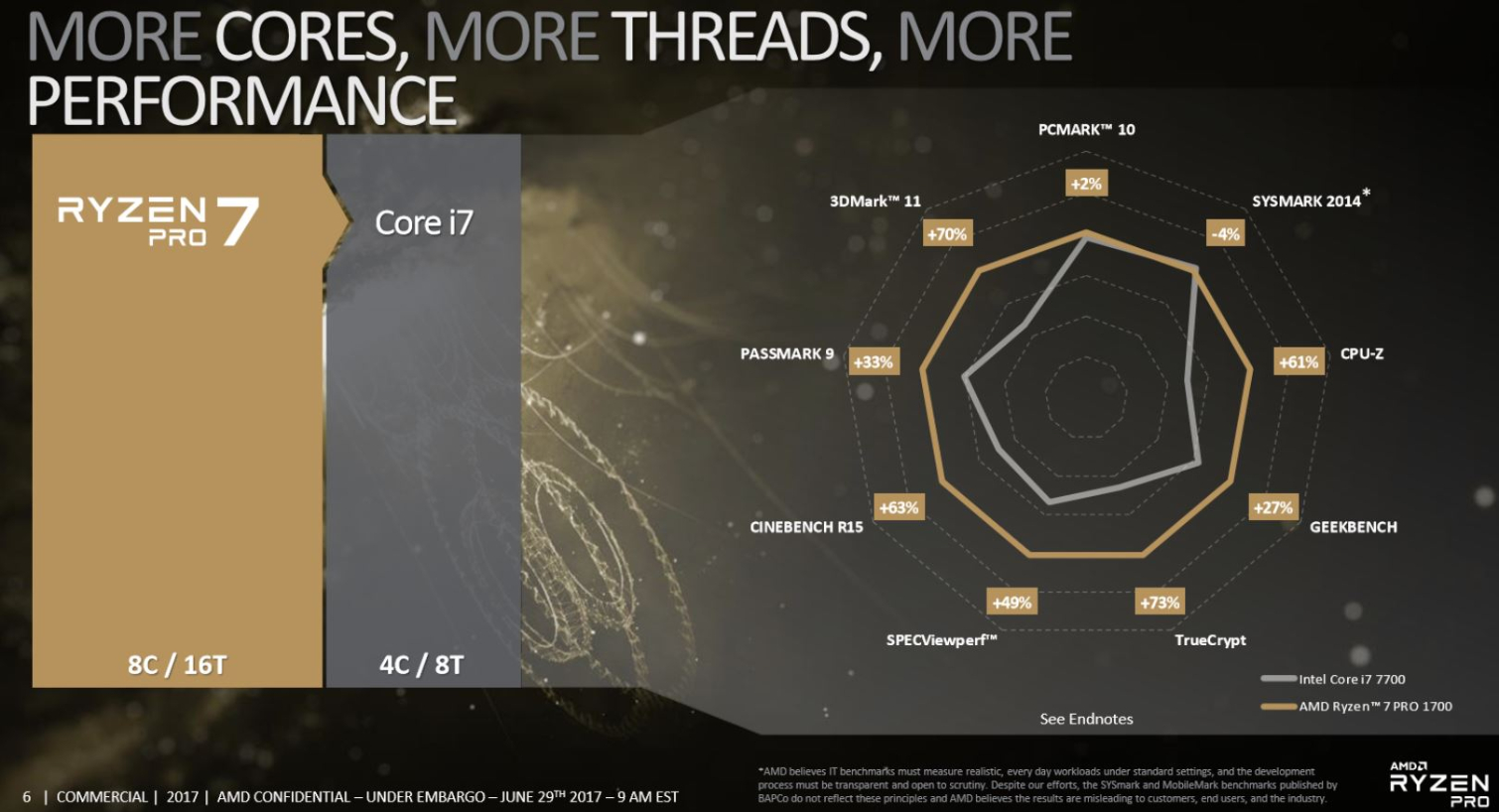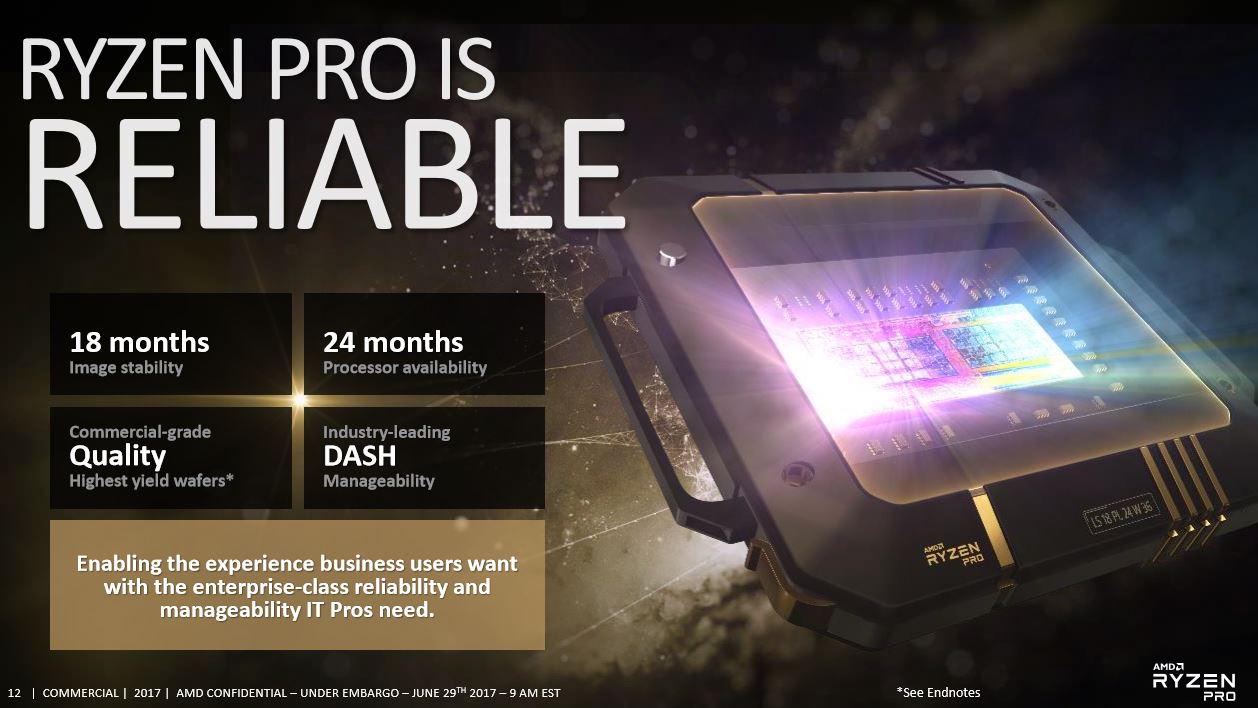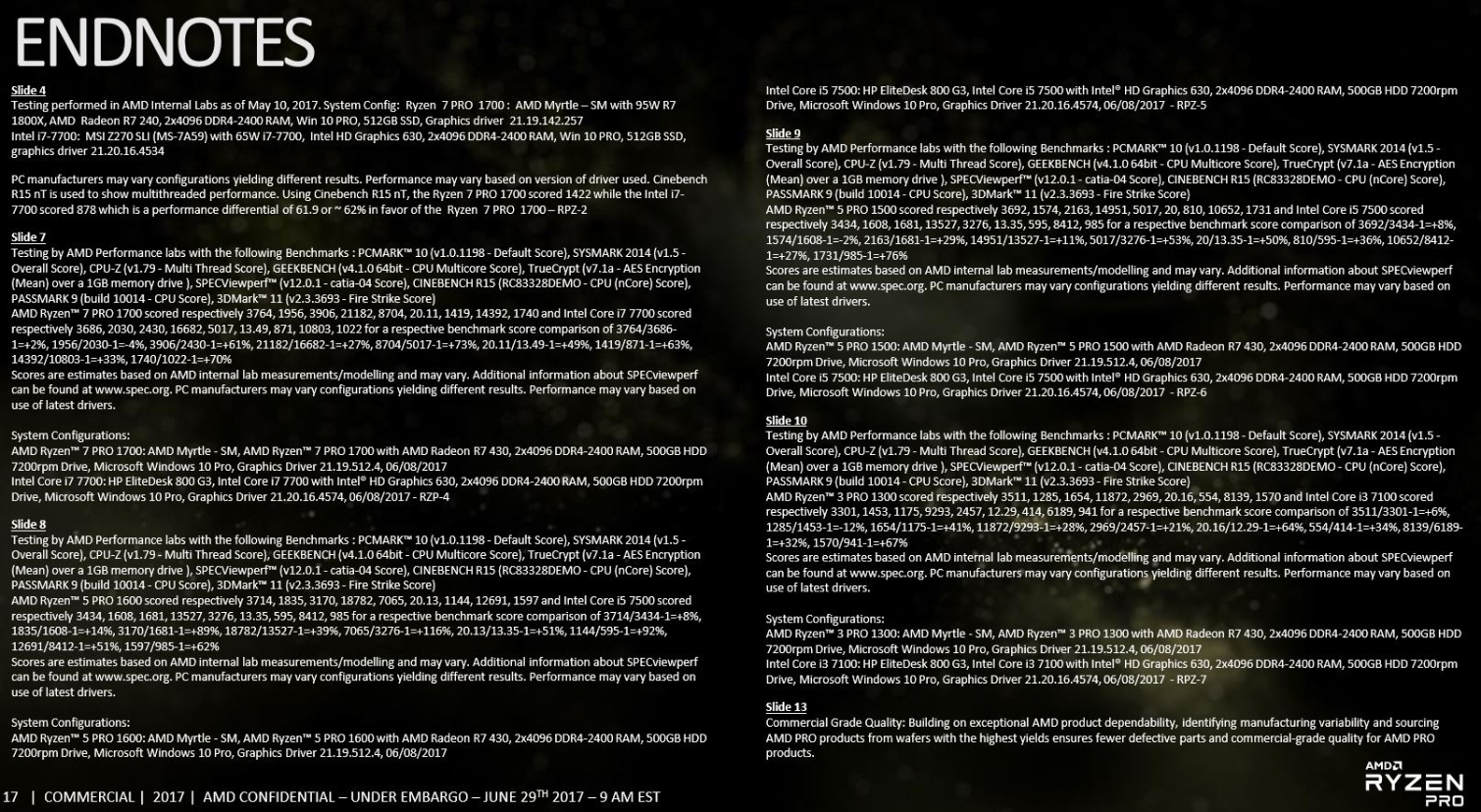AMD Launches Ryzen PRO Series, Offers A Taste Of Ryzen 3
AMD's Ryzen 7 and 5 series processors shook up the market with more cores, threads, and lower price points than Intel's competing models. The company continues that trend with its newly announced Ryzen PRO processors, which include a lineup of Ryzen 7, 5 and 3 models. The Ryzen PRO series is destined for commercial-grade applications, but the Ryzen 3 PRO models should give us some insight into the mainstream Ryzen 3 lineup, which AMD has announced in vague terms without any key details.
AMD has already begun its assault on the mainstream segment with capable processors that challenge Intel's Core i5 and i7 processors, and the forthcoming ThreadRipper promises to bring pressure on the high-end desktop market, as well. The only mountain left to climb comes in the form of the low-end client market and the commercial market.
The Ryzen 3's
The Ryzen PRO series will tackle the full breadth of Intel's mid-range and low-end commercial offerings. The Ryzen 7 and 5 PRO models all carry the same key specifications as their mainstream counterparts, which means the Ryzen 3 PRO's specifications are probably similar to the mainstream Ryzen 3 models that will make their way to the desktop later this year.
Most notably, the Ryzen 3 PRO 1300 and 1200 models weigh in with a 65W TDP and four cores, sans SMT (Simultaneous Multithreading). The Ryzen 3 models are the first Zen-based AMD products to come to market without the company's SMT technology. The rest of the series sports the usual 14nm Zen microarchitectural features, such as the SenseMI suite with XFR, Neural Net Prediction, and Precision Boost.
| Header Cell - Column 0 | Ryzen 7 PRO 1700X | Ryzen 7 PRO 1700 | Ryzen 5 PRO 1600 | Ryzen 5 PRO 1500 | Ryzen 3 PRO 1300 | Ryzen 3 PRO 1200 |
|---|---|---|---|---|---|---|
| Process | 14nm | 14nm | 14nm | 14nm | 14nm | 14nm |
| Microarchitecture | Zen | Zen | Zen | Zen | Zen | Zen |
| Cores/Threads | 8/16 | 8/16 | 6/12 | 4/8 | 4/4 | 4/4 |
| Boost/Base Freq. (GHz) | 3.7/3.5 | 3.7/3.0 | 3.6/3.2 | 3.7/3.5 | 3.7/3.5 | 3.4/3.1 |
| Cache L2+L3 (MB) | 4+16 | 4+16 | 3+16 | 2+16 | 2+8 | 2+8 |
| TDP | 95W | 65W | 65W | 65W | 65W | 65W |
The Ryzen 3 PRO's base and turbo frequencies top out at 3.7/3.5GHz, respectively, which is only slightly lower than the competitive Core i3-7100's 3.9GHz base frequency. We're looking at twice the number of physical cores compared to Intel's nearest competing chips, but the Core i3 series includes hyperthreading to provide the same number of threads. Of course, physical cores will provide more computational horsepower per thread, so the multithreaded advantage should swing to AMD. The company also includes XFR technology, which provides an additional boost (typically in the 50-200MHz range) if the thermal solution is beefy enough, but the company hasn't released the Ryzen 3 PRO's XFR specifics.
Notably, the Ryzen 3 PRO series has a 65W TDP, which is higher than the Core i3-7100's 51W envelope. The higher TDP is somewhat surprising as the Ryzen 3 models do not have an integrated GPU, while the Core i3 series have Intel HD Graphics 630.
The TDP range suggests the Ryzen 3 models have the same dual-CCX design as the Ryzen 7 and 5 series. Each CCX wields 8MB of L3, for a total of 16MB per processor, so Ryzen 3's 8MB of L3 cache implies that AMD has disabled a portion of the cache.
Get Tom's Hardware's best news and in-depth reviews, straight to your inbox.
EDIT: 6/29/17, 9pm PT: AMD confirmed the Ryzen 3 models have have two CCXs, with two cores enabled per CCX.
Performance
AMD claims the processors offer up to 62% more multithreaded performance over some competing solutions. That's a natural side-effect of its heftier core counts.



AMD also provided benchmark results against comparable Intel processors. We've included the endnotes at the bottom of the article for your perusal. The 3DMark 11 FireStrike combined score is influenced by the GPU, so it's worth mentioning that AMD used an Radeon R7 430 discreet graphics card compared to Intel's integrated graphics.
The Ryzen 3 PRO benchmarks naturally grab our attention. AMD's numbers indicate a commanding lead in the breadth of multithreaded tests over the Core i3-7100, with the only loss coming in the SYSmark 2014 test suite. The commanding lead in most of the tests should provide a strong, and much-needed, challenge to Intel's Core i3-7100. To counter AMD, Intel has already made pricing adjustments to its high-end desktop processors. Pressure on the high-volume market segment might engender a similar response.
The Ryzen 7 PRO doesn't suffer as much at the hands of SYSmark: it only falls behind by 4%, while the Ryzen 5 PRO wins in every metric compared to the Core i5-7500. AMD doesn't endorse, in fact it strongly opposes, BAPCo's SYSmark and MobileMark benchmarks due to Intel-specific optimizations. This isn't an AMD-only view--the older versions of the benchmark touched off strong opposition from both AMD and Via.
As such, it's surprising to find SYSmark 2014 among the suite of benchmarks. AMD did include a note at the bottom of the slide to express its general disapproval with the benchmarks, but make no mistake, the company is making a strong statement by including them -- it's obviously very confident in Ryzen PRO's performance.
*AMD believes IT benchmarks must measure realistic, every day workloads under standard settings, and the development process must be transparent and open to scrutiny. Despite our efforts, the SYSmark and MobileMark benchmarks published by BAPCo do not reflect these principles and AMD believes the results are misleading to customers, end users, and the industry.
Commercial-Class Features
Like their desktop counterparts, the PRO series features integrated cryptographic accelerators, such as the AES 128-bit encryption engine we recently put to the test. The processors support the full range of AMD's secure technologies, including Windows 10 enterprise security support and fTPM/TPM 2 (Trusted Platform Module).




Intel segments key features, such as vPro, and doesn't offer the feature on Core i3 models. Much like its full range of processors, AMD offers the full breadth of features on its entire lineup. That also extends to ECC memory support, though AMD notes that it is up to each individual OEM to provide ECC memory support.
Ryzen PRO models include a sandboxed ARM Cortex-A5 Secure Processor (co-processor) that manages security features. It provides a secure root of trust for the secure boot process and manages the Transparent Secure Memory Encryption (TSME) feature, among others. Memory encryption always has a performance penalty, which is a small price to pay for security-conscious organizations. AMD claims it has minimized the performance impact, which is a benefit of using a dedicated co-processor. It hasn't yet provided specific performance measurements with the feature enabled.
The commercial market has unique requirements. Long-term availability assures that organizations can continue to procure processors for large deployments. This is important because these deployments leverage universal images. Image stability is also important because it guarantees drivers will remain unchanged for a period of time. This enables companies to use images over the long term. AMD guarantees 24 months of processor availability and 18 months of image stability. AMD also touts the long-term viability of the AM4 socket, which it expects to soldier on through the next four iterations of its processors, thus providing customers with an easy upgrade path that doesn't require system replacements. The company sees this as an advantage over Intel's more frequent socket changes.
AMD provides a 36-month warranty period and indicates that it uses the highest-quality wafers/die for the PRO processors.
Managing large deployments is also a time-intensive process, so AMD offers its DASH manageability suite with every processor. DASH competes with Intel's vPro suite with a suite of out-of-band management features. Unlike vPro, DASH is open source. That fits into AMD's laudable strategy, which spans from its graphics offerings to desktop and data center processors, of embracing open source tools to break the headlock of proprietary solutions.
Overall the AMD PRO lineup is impressive and offers key differentiating features compared to Intel's processors. However, the lack of integrated graphics will restrict the addressable market and tie the processors to larger systems with discreet graphics cards. AMD has it's APU's in development for later this year, which should help address those issues.
AMD is quite bullish on the prospects -- the company plans to grow its commercial business 45% by the end of the year. The Ryzen PRO series launches in the second half of 2017 (more information, such as pricing, to come August 29), followed by its Ryzen PRO mobile variants in the first half of 2018. AMD plans to release the Ryzen 3 series for the consumer desktop in Q3.

Paul Alcorn is the Editor-in-Chief for Tom's Hardware US. He also writes news and reviews on CPUs, storage, and enterprise hardware.
-
WildCard999 I'm interested in seeing what the pricing will be and how it compares price/performance to the G4560.Reply -
gggplaya Considering these are "pro" as in professional chips, they'll all be too overpriced for the consumer.Reply -
Cromwell__ Okay, n00b question: So if the Ryzen 5 and 7 PRO versions have the same exact specs as their non-Pro counterparts, what is the point of them? Are they completely identical, so this is 100% marketing to businesses without any actual features?Reply -
panathas Reply19879856 said:Okay, n00b question: So if the Ryzen 5 and 7 PRO versions have the same exact specs as their non-Pro counterparts, what is the point of them? Are they completely identical, so this is 100% marketing to businesses without any actual features?
From the article: "Ryzen PRO models include a sandboxed ARM Cortex-A5 Secure Processor (co-processor) that manages security features. It provides a secure root of trust for the secure boot process and manages the Transparent Secure Memory Encryption (TSME) feature, among others. Memory encryption always has a performance penalty, which is a small price to pay for security-conscious organizations. AMD claims it has minimized the performance impact, which is a benefit of using a dedicated co-processor. It hasn't yet provided specific performance measurements with the feature enabled."
Also: "AMD provides a 36-month warranty period and indicates that it uses the highest-quality wafers/die for the PRO processors." -
nitrium Is there a reason the Ryzen chips with the lower core counts aren't clocked any higher? I get why an 8 core chip's clockspeed would be thermally constrained to relatively low frequencies, but you'd think you could trivially clock a 4/4 or 4/8 chip at 4+ GHz, which would make it more competitive with Intel's 4 core CPUs.Reply -
g-unit1111 The Ryzen 3s look very nice. 4 cores for the price of an Intel i3 plus overclocking ability? I'm in. Also I'm really interested in the Ryzen APUs. I'm hoping those will be the HTPC game changers that AMD is advertising.Reply -
SuperFist Is it really all black!? Damn, I like that! Too bad Ryzen 7 didn't come in that color.Reply -
bit_user Reply
You can bet they're going to be cheaper than comparable E3 Xeons, which generally cost only a bit more than their mainstream counterparts (until you reach the fastest couple SKUs). In other words, probably not much more than the corresponding mainstream Ryzens.19879776 said:Considering these are "pro" as in professional chips, they'll all be too overpriced for the consumer.
I'm interested in the Ryzen 3 PRO to upgrade my fileserver. But I might just wait for the APU version.
It strikes me as odd that the author seems to think the Ryzen 3 die includes two CCX's. Maybe one is broken/disabled. Depending on their expected volumes and defect rates of the full Ryzens, AMD could also just make single-CCX dies and fit more per wafer. -
bit_user Reply
Yeah, but they'll both look the same with the heatsink on. Whatever's in your box, you can still use the Ryzen PRO photos as desktop wallpaper.19880596 said:Is it really all black!? Damn, I like that! Too bad Ryzen 7 didn't come in that color.
-
Paul Alcorn Reply19881297 said:
You can bet they're going to be cheaper than comparable E3 Xeons, which generally cost only a bit more than their mainstream counterparts (until you reach the fastest couple SKUs). In other words, probably not much more than the corresponding mainstream Ryzens.19879776 said:Considering these are "pro" as in professional chips, they'll all be too overpriced for the consumer.
I'm interested in the Ryzen 3 PRO to upgrade my fileserver. But I might just wait for the APU version.
It strikes me as odd that the author seems to think the Ryzen 3 die includes two CCX's. Maybe one is broken/disabled. Depending on their expected volumes and defect rates of the full Ryzens, AMD could also just make single-CCX dies and fit more per wafer.
The TDP gave it away. Much like we suspected from out power testing on the lower core-count Ryzen 5 1600X, the disabled cores likely still draw power.
http://www.tomshardware.com/reviews/amd-ryzen-5-1600x-cpu-review,5014-9.html
In either case, I followed up with AMD on the matter. The response came after the piece went up.
Q: Can you confirm if the Ryzen 3 PRO models have one or two CCX per chip?
A:
They have two CCXs, two cores enabled per CCX.
